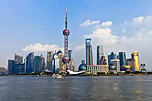Dear Professors and students,
Ladies and gentlemen,
Good afternoon.
I am very pleased to be here with you at the Renison University College, talking about China's diplomacy, its economy and its relations with Canada.
Talking about diplomacy, you may wonder what kind of job it is as a diplomat. So I will start my speech by introducing what the Chinese diplomats do.
The first mission is to promote the friendship between China and other countries and regions. By another words, through our efforts, we will make more and more friends for China and further strengthen relations between China and countries in the world. For example, the consular area of the Chinese Consulate General in Toronto includes Ontario and Manitoba. One of our important responsibilities is to enhance the exchanges and cooperation between China and the two provinces, bring tangible benefits to both sides, and advance the friendship between the two peoples.
The second mission is to actively participate in formulating the international regulations and laws, and dealing with global affairs. In the international institutions such as the United Nations, the World Trade Organization, the International Monetary Fund and the World Bank, the Chinese diplomats are making joint efforts with their counterparts from all over the world to set rules for the interactions between countries. Besides, for global issues like climate change, terrorism and epidemic diseases, as well as regional hot spot issues like Syria and Iran nuclear issues, there usually are requirements for all relating countries even the UN Security Council to work out solutions. As a responsible major country and permanent member of the UN Security Council, China has been playing a constructive role in these issues.
The third mission is to provide consular services and protection. Everyday, we issue different types of visas to foreigners who plan to tour, visit, study or work in China. We issue new passports for Chinese citizens, whose passports are expired, lost or damaged. Moreover, millions of Chinese citizens are working and living abroad, while more than 30,000 Chinese enterprises are doing businesses overseas. Therefore, it has become a more and more important responsibility for our diplomats to protect the safety of the lives and properties of overseas Chinese citizens and enterprises, and protect their lawful and legitimate rights and interests.
In addition, the Chinese diplomats are required to publicize China and to tell a real story about China to the world. So today I would like to share with you some real picture about China. It may be different from what you have been told by the local media.
Recently, there are various comments on China's economy. My observation is that China's economy is in a generally stable track and with bright prospects. Let's just take a quick look at where we were last year.
Firstly, China's economic growth still took the lead worldwide. Faced with continued weak world economic recovery in 2015, China's GDP grew by 6.9 percent, which means over 500 billion US dollars. This increment is equivalent to the total GDP volume of Sweden or Argentina. The growth rate of China's GDP ranks top among major global economies. China contributed 25% to the world's economic growth.
Secondly, China's economy grew with robust impetus. When it comes to consumption, in 2015, Chinese people's per capita disposable income increased by 7.4%, which drove the consumption to maintain a double-digit growth and contribute 66.4% to the GDP. When it comes to investment, some people talked about capital outflow. But the truth is that in 2015, China attracted 136 billion USD foreign direct investments with an increase of 6%, ranking the 3rd all over the world and 1st among developing countries. When it comes to trade, in 2015, the international market share of China's export raised from 12.4% to 13.4%.
Thirdly, the quality of China's economic growth has been significantly improved. The Chinese government substantially reduced the administrative interventions. The outdated industrial capacity was further eliminated. The contribution from consumption and service sector to the economic growth raised significantly, which steadily upgraded the economic structure and benefits.
Today, the 4th Session of the 12th National People's Congress, the most important annual conference in China, just concluded. Chinese Premier Li Keqiang delivered his report on the work of the government at the Session. The report indicated that China's economy in 2016 will grow by 6.5% to 7%. China will stick to the course of reform and opening up, strengthen structural reform on the supply side, foster new momentum for economic growth, and continually improve people's living standard and keep the economy operating within a proper range. In order to achieve the above targets, the Chinese government will focus on implementing the following measures.
No.1, stabilize and improve the macro-economic policies. On one hand, we will increase the fiscal deficit to reduce more than 500 billion RMB (approximate 75 billion USD) of tax burden for both enterprises and individuals. On the other hand, the prudent monetary policy will be sustained to keep a reasonable and adequate liquidity and lower the financing cost, providing more support to the real economy and small business.
No.2, strengthen supply-side structural reform to drive sustained growth. We will carry out supply-side structural reform to improve the quality and efficiency of the supply system, and further stimulate market vitality and the creativity of society.
No.3, implement the strategy of innovation-driven growth, let the science and technology more deeply embedded in the economy, and improve the overall quality and competitiveness of the real economy.
No.4, maintain a stable growth and adjust the economic structure. On one hand, we will tap the potential of the domestic demand, and strengthen the basic role of consumption in promoting economic growth. We will support the growth of consumption in the elderly care, in services of the area of health, housekeeping, education and training, and culture and sports. We will work to strengthen the growth of emerging areas of consumption such as information, smart homes, and personalized fashion. On the other hand, we will see that effective investment plays a key role in maintaining stable growth and making structural adjustments. This year, we will launch a number of projects set forth in the 13th Five-Year Plan. More than 800 billion yuan (about 120 billion USD) will be invested in railway construction, and investment in road construction will reach 1.65 trillion yuan (about 247.5 billion USD). A further 20 water conservancy projects will be carried out.
Fifthly, advance new urbanization. We will move faster to see that urban residency is granted to more people with rural household registration living in urban areas. We will promote the development of government-subsidized housing in urban areas, and the steady and healthy development of the real estate market. We will redouble our efforts to improve urban planning, development, and management.
Looking into 2016, China is confident to maintain the healthy and stable development of the economy, and to make new contributions to the world's economic growth.
Ladies and Gentlemen,
In 2015, all-round progress was also made in advancing the major-country diplomacy with distinctive Chinese features. We stayed committed to peaceful development and national rejuvenation. Focusing on the themes of peace and development, we made historic progress. China's international status and influence, including the institutional ones, improved significantly. China enjoyed a favorable position in interactions among major countries, played a more active role in dealing with hot-spot issues, and made great strides in advancing relations with developing countries. The RMB was adopted by the IMF to be a global reserve currency in the Special Drawing Right basket. The Asian Infrastructure Investment Bank was set up and put into operation. We comprehensively promoted the "The Belt and Road Initiative", providing strong impetus to the development and revitalization of countries along the routes.
Recently, many people has put a lot of attention on the issue of the South China Sea, Now I would like to spend a few minutes talking about the current situation in the South China Sea.
The historical development of the South China Sea issue is very clear. China was the first country to discover, name, develop, and continuously exercise sovereign jurisdiction over the South China Sea islands. Until the second half of 19th century, there were only Chinese people living and engaging productive work in the most southern part of the South China Sea Islands, namely the Nansha Islands. This is clearly recorded in many western countries' historical materials. During the Second World War, Japan once occupied the Nansha Islands. But after the war, China recovered the islands, and declared the sovereignty and strengthened the administration, through naming, releasing map, administrative setting and military stationing. All major countries, including the United States, the Soviet Union and France, admitted that Nansha Islands belongs to China. Japan made a clear commitment to abide by relevant provisions of the Potsdam Proclamation, to give up claims to China's Taiwan, Penghu Islands, Xisha Islands and Nansha Islands. For a long time, both the Vietnamese government and civil society explicitly recognized China's sovereignty over Xisha Islands and Nansha Islands. But since the 70s of the 20th century, certain countries violate the principle of mutual respect of sovereignty and territorial integrity, which is enshrined in the Charter of the United Nations. These countries illegally occupied 42 islands by force. It resulted in the territorial dispute of the Nansha Islands. And this is the core and root of the South China Sea issue.
With UN Convention on the Law of the Sea (UNCLOS) going into effect in 1982, the issue of maritime delimitation emerged between China, Vietnam, the Philippines and other countries. The Philippines attempt to simplify the South China Sea dispute into the interpretation and application of UNCLOS, trying to use their claims of marine jurisdiction to deny China's sovereignty over Nansha Islands, and to cover up their illegal occupation of the Chinese Nansha Islands. It is essentially an attempt to use UNCLOS to deny the obligation of mutual respect of sovereignty and territorial integrity in the UN Charter. The Philippines unilaterally initiated the South China Sea arbitration. China neither accepts nor participates. China does so with a full international law basis. Back in 2006, China exercised its right under the Article 298 of UNCLOS and made a declaration that excluded compulsory arbitration. More than 30 other countries have made similar declarations. All UN Security Council Permanent Members made similar declarations, except the US who did not join the UNCLOS. Meanwhile, the Philippines' action violated its own commitments to resolve the issue through bilateral negotiation in agreements with China and in the Declaration on the Conduct of Parties in the South China Sea (DOC).
Recently, construction activities by China in some stationed Nansha Islands drew close attention. Some questions such as "threat to freedom of navigation", "change the status-quo of the South China Sea," and "militarization " emerged. In fact, no commercial vessel has complained that its freedom of navigation had been jeopardized. China never expanded its territorial claims, claimed on the territory of other countries, or occupied other countries' territory by force. China's construction activities and deploying necessary homeland defense facilities in some islands, are exercising the right of self-preservation and self-defense according to international law. It is a necessary response when facing more and more threats and pressures in the South China Sea.
China wants to have a peaceful resolution of the issue through dialogue and negotiation. We are working with the ASEAN countries to implement the Declaration on the Conduct of Parties in the South China Sea, and we are speeding up consultation on a code of conduct in the South China Sea (COC). China and the ASEAN countries have every capability to maintain peace and stability in the South China Sea on our own.
Last but not the least, I would like to talk about the China-Canada relations. The friendship between our two countries goes a long way back. Over a hundred years ago, the first group of Chinese workers came to this country and built its first transcontinental Pacific Railway. During the Second World War, China and Canada fought side by side against the common enemies. The heroic deeds of Dr. Norman Bethune have been remembered and cherished by the Chinese people. In the early 1960s, Canada was the first Western country to do business with China by exporting wheat to us. In 1970, Canada became one of the first Western countries to establish diplomatic relations with China, opening a new chapter of our bilateral relations.
The year of 2015 marked the 45th anniversary of the diplomatic ties between China and Canada. With a steadily growing trade volume of 55.7 billion US dollars, China remains the second largest trading partner of Canada. The first clearing center in North America for the RMB was officially opened and operated in Toronto. Chinese students in Canada reached 140 thousands. Mutual agreement to issue multiple-entry visas valid for 10 years facilitated a closer people-to-people exchanges. Currently, there are 132 flights between China and Canada every week and over 3000 people traveling between the two countries every day. In November 2015, President Xi Jinping and Prime Minister Justin Trudeau met for the first time and reached broad consensus during their meetings, providing a right direction for further development of China-Canada Strategic Partnership. Recently, there was another joyful event for the two peoples. On March 7, Prime Minister Trudeau visited the Toronto Zoo and unveiled the names of the twin panda cubs Jia Panpan and Jia Yueyue, and Chinese Premier Li Keqiang sent a message of congratulations.
Here I would like to draw your attention to China-Canada economic and trade relations. We are expecting that Canada will take a step forward, so that our two sides can initiate negotiations on the free trade agreement as early as possible. China has concluded 14 free trade agreements with 22 countries and tariff territories and is now undergoing another 8 FTA negotiations. It's worth mentioning that in 2015, China successfully concluded the bilateral FTA negotiations with Australia. The economies of Australia and Canada have some similarities, both in capacity and structure. Yet Australia is now ahead of Canada in terms of its trade with China, and Canada's export to China both in goods and services is facing fierce competition from Australia. Recently, a report commissioned by the Canadian Council of the Chief Executives and the Canada-China Business Council estimated that, a free trade deal would increase Canadian exports by 7.7 billion dollars and increase Canadian GDP by 7.8 billion dollars by 2030, supporting 25,000 new jobs and benefiting many sectors such as automobile manufacturing, chemical industry, machinery and agriculture. We hope the Canadian government can make up its mind as soon as possible and start the negotiation with China, which we believe is in the best interest of our two countries.
Ladies and gentlemen,
Looking ahead, China will continue to be the powerhouse for the global economy and a great contributor for the world peace and development. The friendship between China and Canada will certainly be enhanced to a new stage. A country's future rests on the shoulders of the young generation. I hope that in the near future, the young people here today, with a deeper understanding of China, will become an important driving force of the China-Canada friendship.
Thank you. Now I'm ready to take your questions.




